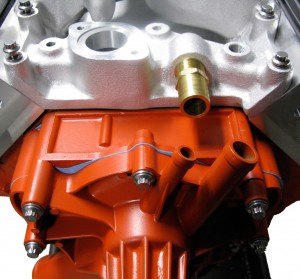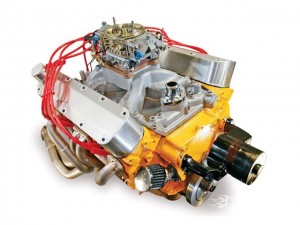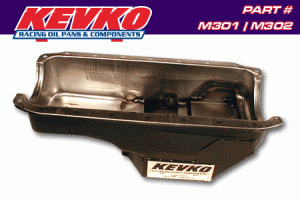There are a lot of areas where the Magnum’s base horsepower can and should be improved. As we have demonstrated with our shop Dodge Dart, it is possible to turn a junkyard engine into a real screamer. Attention to detail and a little extra money spent in the right places are the keys to success.
Cylinder Heads
The key to horsepower is good cylinder heads. Magnum engines have some of the best flowing heads Mopar has ever released. Unfortunately, they are prone to cracking between the seats. This makes spending money to upgrade them dicey, at best. Considering the affordability of some aftermarket options, and the performance gains realized with them, we think putting a new set of heads on your Magnum is a must.
Through research, we’ve found the best bang for your buck is a set of Engine Quest heads. These heads, made by Australian company Engine Quest (also called EQ), were created as a stock replacement for the Ram truck guys (and gals) when their factory induction-hardened heads inevitably cracked. Being gearheads themselves, EQ designed heads that flow even better than factory castings. They even created a version with the LA intake bolt pattern.
RHS also makes improved iron heads for the Magnum (and LA). They carry many of the same improvements as the EQ heads, with a slightly larger combustion chamber (62cc). They are more expensive than the EQ and may not flow as well. I think they are “missing the boat” a bit by not offering a Magnum compatible head with the LA bolt pattern. Details Here:
Edelbrock also makes heads for the Magnum. Edelbrock’s castings have the advantage of being aluminum, but are significantly more expensive than EQ heads, and may not flow as well. Edelbrock does not sell their Magnum heads with the LA intake bolt pattern.
Head Gaskets
Magnum engines have more consistent machining than their LA predecessors, but the factory piston is still about .050 inches down from top dead center on most engines. This reduces compression potential, and thus horsepower. Fortunately, there’s an easy solution for getting some of that compression back — opt for a skinnier-than-stock head gasket. We used Mr Gasket .028 thick gaskets on our shop car, and we’ve never had a failure or a leak. They’re about half the thickness of a stock gasket. Cleanup is a snap as well. They seal well and increase compression significantly over stock. With a true 58cc casting such as the EQ Magnum or Edelbrock Performer RPM heads you’ll be in the vicinity of 9.5:1 compression with the stock short block.
Camshaft
If you’re swapping the Magnum into a car, and you’re interested in performance and horsepower, shelf-stock camshaft options for the Magnum engine are limited. There are some adequate cams from Mopar crate motors, but almost all of the shelf offerings from Comp, Crane, etc. are intended for big trucks and low-end torque, rather than high RPM performance.
The best camshaft solution is a custom grind. For a little more than a shelf camshaft costs, the experts at Comp Cams will custom grind a camshaft for you, and you’ll get you a cam specifically designed for your car and engine combination. Additionally, you can have it ground on an LA style cam core to get the proper snout for running a fuel pump eccentric if you want to run a mechanical fuel pump. Watch this space in the future for true performance camshafts available to Magnum swappers! We will have cams to order without the hassle of having a custom grind.
Important note: On custom cams, the base circle is typically a little smaller than the stock Magnum cam, necessitating longer pushrods. These affordable stock replacements work well for most applications. Serious racers should seek a more robust solution than stock or cheap replacement pushrods, but those linked to above have served us very will in our shop car.
Important note 2: There is a persistent rumor that the Magnum engine will not tolerate camshafts with higher than .520 lift due to retainer/lock to valve guide clearance issues. This is not true. While max lift is related to cam duration and other factors, we are using a .550+ lift cam in our shop car, did not need to flycut the pistons, and have more than the minimum clearance.
Important note 3: You should ALWAYS check piston/valve clearance and retainer/guide clearance when installing a new cam.
Hydraulic Roller Vs. Flat Tappet
You could, theoretically, use a flat tappet LA camshaft in your Magnum engine, but we advise against it. The hydraulic roller system, stock on all Magnum engines, is superior for producing horsepower and requires no maintenance. Even better, there is no cam break in, worry over zinc levels in the oil, or other flat tappet hassles to worry about. Additionally, hydraulic roller lifters are reusable after a cam change.
Valve Springs
In all cases, the proper valve springs should be used. Stock Magnum valve springs are very weak, and should be changed before installing a performance-oriented camshaft. As the springs are sort of unusual, we recommend getting expert advice before choosing springs for your combination. Hughes and Mopar sell replacement springs for Magnum engines.
Rocker Arms
Owners of LA smallblocks were spoiled for years by the old school Mopar’s use of shaft rockers. Sadly, this did not continue. On Magnum engines Chrysler opted for a pedestal rocker arm system very similar to what Ford used on 5.0 Mustangs.
Though many enthusiasts have reservations about them, we have spun the stock rockers to 6500 RPM regularly without failure. They are stronger than they appear. For more serious racers, there are aftermarket replacements available from numerous sources, and there are kits to convert the bolt down “pedestal” style rockers to “stud mount,” enabling Magnum owners to use cheap Chevy-style stud mount rockers. Our advice is to stick with the stock stuff for anything but an all-out race effort.
Intake Manifold
For carburetor users seeking the ultimate intake for performance and streetability, there’s only one choice: Edelbrock’s LA RPM Air Gap. An out-of-production LD340 might come close, in terms of horsepower, so we give it second place. Keep in mind, the above-listed modifications are required to use LA intakes on Magnum heads.
If you don’t want to go to the trouble of having the heads drilled, Edelbrock makes a direct fit Air-Gap for stock Magnum style intake bolts. Be warned it has smaller runners and an inconveniently placed bypass inlet for V-belt use (as shown below).

Note the greater than 90* angle the bypass hose has to take from the water pump to the bypass on the intake. Note also truck style thermostat housing on this intake.
The most affordable intake option is Pro Product’s Crosswind intake. This intake has dual bolt patterns for use with either LA or Magnum bolt patterns, and is also an air-gap style intake. This intake has smaller runners than its Edelbrock brethren, and is sourced from China.
Oil Pan
Looking inside most modern oil pans, you’ll find internal baffles designed to keep the pickup covered and keep oil away from the crankshaft. The OEMs do this for efficiency and improved mileage. However, good oil control also has the benefit of reducing drag on the crank, which frees up horsepower. Given these performance improving factors, and considering you’ve got to change the oil pan on your Magnum to fit a classic Mopar anyway, it’s hard to justify settling for a stock or stock replacement pan.
We use a pan from Kevko Racing and highly recommend it. It is not a show piece, but does an excellent job of controlling unwanted windage, and has features usually found only on units costing twice as much. Kevko has recently begun offering the same pan in aluminum. We’ll update when we’ve tried it out.
For a nifty trick regarding oil pan gaskets check here: Tips and Tricks
Other Gaskets
It is unfortunately very common for enthusiasts to buy the “best” possible parts, and then lose out on some of the performance benefit by installing gaskets that partially obscure the intake and exhaust ports resulting in reduced airflow. The gaskets provided with headers are typically the worst offenders and are also prone to blowouts.
We recommend these Edelbrock gaskets with your magnum to avoid this problem — and even these may need a little trimming on the intake side.
Intake (with Magnum bolt pattern): Edelbrock 7277
Intake (with LA bolt pattern): Edelbrock 7276
Exhaust: Edelbrock 7237
Stroker Kits
If 360 is good, 408 is better. These choices are a little outside our current scope, but there are several shops that can help out if you want to go with a Magnum stroker:
Pistons
A word about pistons. The Magnum’s stock pistons are a hypereutectic design. While they are technically cast, the stock Magnum pistons are much stronger than conventional cast pistons from the 1970s. They are not, however, as strong as forged pistons and there are many horror stories related to nitrous and/or forced induction usage with hyper pistons. We believe these fears are radically overstated.
Detonation is what typically kills hypereutectic pistons, and even without detonation pistons will ultimately fail at lower horsepower levels than forged pistons. Also, unlike a forged piston, when a hypereutectic piston fails, it shatters, spreading pieces throughout the engine, likely trashing the whole shortblock or worse.
With these warnings in mind, we have sprayed and boosted way beyond the generally accepted “safety realm.” If your tune is good and you don’t get greedy, you will be surprised by the durability of these pistons. With a good tune, proper air/fuel ratios, and good 93 Octane gasoline we’ve hit them time and again with a 200 shot of nitrous, and 15 pounds of boost without a failure. (NOT at the same time!!!) Your mileage may vary, and there are no guarantees, but for the average enthusiast who uses his head, the stock pistons shouldn’t pose a problem.


